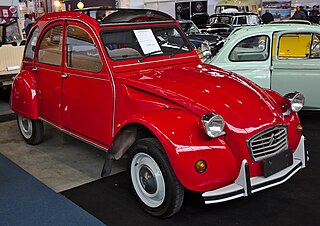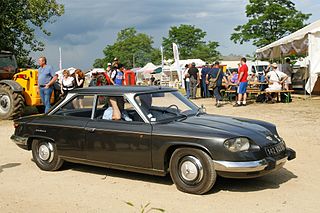This article does not cite any sources .(March 2010) (Learn how and when to remove this template message) |
The Hoffmann 2CV Cabrio is a kitcar based on the Citroën 2CV.

The Citroën 2CV is an air-cooled front-engine, front-wheel-drive economy car introduced at the 1948 Paris Mondial de l'Automobile and manufactured by Citroën for model years 1948–1990.

In 1988, Wolfgang Hoffmann developed the design and the first prototypes. A lot of Hoffmann 2CV Cabrios have been built as a homework project. Approximately 250 professionally manufactured vehicles left the workshop in Hohenfurch. The kit contains a fibre glass reinforced plastic body with steel frame, two side windows, soft-top, trunk lid and all necessary screws, bolts, hinges etc.

Homework, or a homework assignment, is a set of tasks assigned to students by their teachers to be completed outside the class. Common homework assignments may include required reading, a writing or typing project, mathematical exercises to be completed, information to be reviewed before a test, or other skills to be practiced.

Hohenfurch is a municipality in the Weilheim-Schongau district, in Bavaria, Germany.
To this day approx. 1700 Hoffmann cabrios are registered in Europe, mainly in Germany and France. Some vehicles have also been sold to Japan and the USA.

Europe is a continent located entirely in the Northern Hemisphere and mostly in the Eastern Hemisphere. It is bordered by the Arctic Ocean to the north, the Atlantic Ocean to the west and the Mediterranean Sea to the south. It comprises the westernmost part of Eurasia.

Germany, officially the Federal Republic of Germany, is a country in Central and Western Europe, lying between the Baltic and North Seas to the north, and the Alps to the south. It borders Denmark to the north, Poland and the Czech Republic to the east, Austria and Switzerland to the south, France to the southwest, and Luxembourg, Belgium and the Netherlands to the west.

France, officially the French Republic, is a country whose territory consists of metropolitan France in Western Europe and several overseas regions and territories. The metropolitan area of France extends from the Mediterranean Sea to the English Channel and the North Sea, and from the Rhine to the Atlantic Ocean. It is bordered by Belgium, Luxembourg and Germany to the northeast, Switzerland and Italy to the east, and Andorra and Spain to the south. The overseas territories include French Guiana in South America and several islands in the Atlantic, Pacific and Indian oceans. The country's 18 integral regions span a combined area of 643,801 square kilometres (248,573 sq mi) and a total population of 67.3 million. France, a sovereign state, is a unitary semi-presidential republic with its capital in Paris, the country's largest city and main cultural and commercial centre. Other major urban areas include Lyon, Marseille, Toulouse, Bordeaux, Lille and Nice.
The company is also producing spare parts for the Citroën 2CV, and other Citroën A-Types, like stainless steel chassis and fibre glass body parts.














